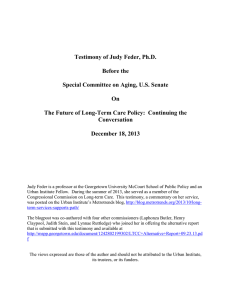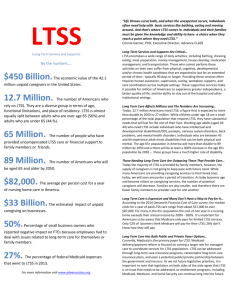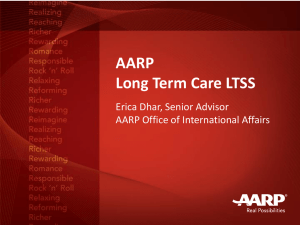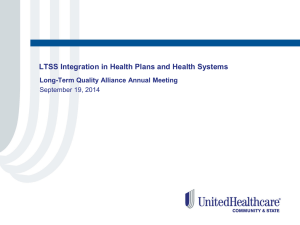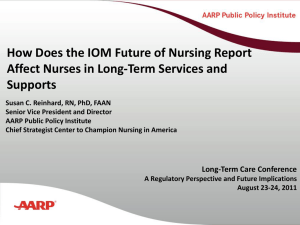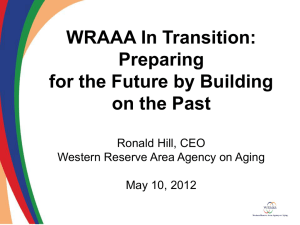Perspectives on the Challenges of Financing Long
advertisement
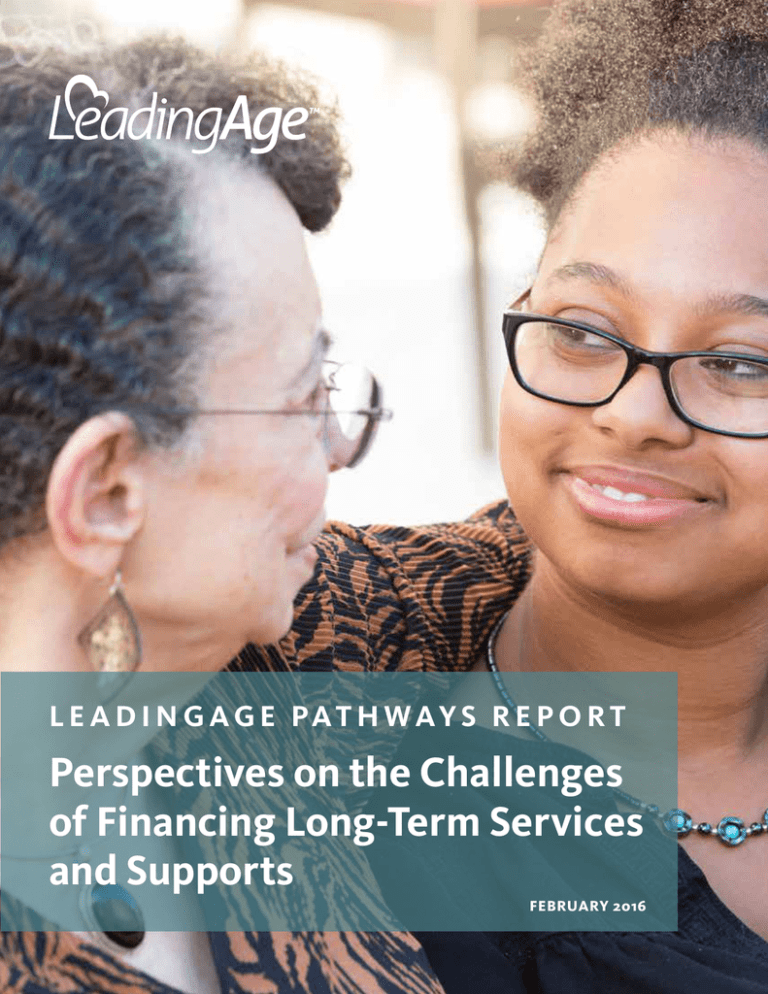
L E A D I N G A G E PA T H W A Y S R E P O R T Perspectives on the Challenges of Financing Long-Term Services and Supports FEBRUARY 2016 We have historically embraced some of the most intractable challenges in our communities and found abiding solutions. As the ground shifts beneath us, we must again come together and put this same wisdom to work. —KATHRYN ROBERTS, CHAIR LeadingAge Board of Directors EXECUTIVE SUMMARY Recent research conducted by Urban Institute and Milliman, Inc. on behalf of LeadingAge, The SCAN Foundation, and AARP shows definitively that the nation’s current methods for financing long-term services and supports (LTSS) are unsustainable, irrational, and unfair for individuals and families. to increase over the next decades. Therefore, it is essential that we find ways to: LeadingAge believes America needs a fairer and more rational financing system to ensure access to quality LTSS. Based on research, discussions, and modeling work conducted over the last 12 years, we know that workable solutions can be developed to reach this goal. LeadingAge is seeking a different future for a variety of stakeholders – including older adults, younger people with disabilities, families, paid and unpaid caregivers, employers, middle-income individuals, LTSS providers, federal and state governments, and taxpayers. We believe that a new system of financing LTSS needs to be insurance-based and guided by the principles of rationality, equity, and affordability. 1. There is new evidence that the current LTSS financing system is untenable. 2. A universal insurance approach that covers catastrophic costs would have the greatest positive impact on both individuals and strained public programs, while creating a more rational system. WHY NOW? Three pressing challenges are driving our efforts to reform the financing system for LTSS. The status quo is unsustainable. There is no doubt that LTSS costs will continue to rise and spending will continue n Help Americans plan for and meet their LTSS needs. n Honor the critical role of families without crippling them financially. n Reduce reliance on Medicaid. The existing system for LTSS financing is irrational. Personal savings and Medicaid will continue to be the de facto sources of LTSS financing, due to limited LTSS coverage under Medicare and the fact that the private insurance market offers few affordable options to pay for LTSS. Consider this: n Private, long-term care insurance currently covers less than 10% of LTSS expenditures. n Medicare benefits are largely limited to coverage of postacute care (services received after hospitalization). The LTSS financing system is unfair. We can no longer tolerate an approach that grants access to LTSS only to those with high levels of wealth or low levels of income and wealth. Consider this: n Wealthy individuals have the ability to plan for their care needs and to pay for that care privately or by purchasing private insurance. n Individuals living in poverty can access their state’s Medicaid programs to meet LTSS needs. n Middle-income consumers, on the other hand, are left with few options other than depleting their savings, relying heavily on unpaid family caregivers, or living with unmet needs. LeadingAge Pathways Report: Perspectives on the Challenges of Financing Long-Term Services and Supports | 1 HOW SHOULD WE EVALUATE THE PROPOSED SOLUTIONS? Ultimately, the solutions we adopt to address the challenges listed above should provide reasonable protections to allow any individual who requires LTSS to live with dignity and independence. While we recognize that the need for LTSS is not limited to older people, in this report we have limited our focus to the 65 and older population modeled by the Urban Institute and Milliman, Inc. Several important assumptions will shape our understanding of these proposed solutions: n The need for LTSS is a risk, not a certainty, for any one person. However, for those needing LTSS, the costs far exceed an individual’s ability to pay. n Widespread participation is essential. Insurance products that spread risk broadly generally require higher levels of participation to optimize coverage and costs. n Affordability and value should be key characteristics of any insurance product that is designed to protect against LTSS risk. Consumers will not be interested unless they believe that its costs can be incorporated into their budgets and that its coverage represents a value, compared to other household priorities. 2 | LeadingAge Pathways Report: Perspectives on the Challenges of Financing Long-Term Services and Supports INTRODUCTION Each and every day, LeadingAge members witness the devastating effects that our nation’s dysfunctional LTSS financing system has on older adults and their families. These not-for-profit and mission-driven organizations have taken the lead in creating and delivering the most innovative, forward-thinking, and high-quality services currently available in the home and in community settings. Yet, despite their innovation, creativity, and commitment to service, these LeadingAge members face real and serious limitations: n They do not have the resources to help every family caregiver who is exhausted or struggling to keep up with often overwhelming responsibilities. n They cannot provide the funds or services necessary to help every older adult in need. These are real problems that we hear from our members every day. PREDICTING THE LTSS FINANCING CRISIS LeadingAge is committed to creating a better experience for people as they age. We have long recognized that the nation’s methods of financing LTSS are inadequate. In 2004, we convened a Finance Cabinet comprised of leaders from LeadingAge member services organizations. The Cabinet conducted an in-depth examination of then-current approaches to long-term care financing. Based on that study, it predicted an impending crisis in the financing and delivery of LTSS, as a result of expected increases in the number of people living to old age who would need assistance. The Finance Cabinet concluded that: n The LTSS financing crisis arose from the fact that the current primary methods of paying for services – the Medicaid program and private pay – are not sustainable. n The need for services was a risk, not a certainty. Therefore, LeadingAge should consider the role of both public and private insurance when exploring ways to avoid the coming LTSS financing crisis. During the next six years, LeadingAge worked in concert with other advocacy and consumer organizations representing older adults and younger people with disabilities to advocate for CLASS, a voluntary, federally administered, consumer financed insurance plan that would have provided participants with cash to help pay for needed assistance. CLASS was included in the Affordable Care Act, but was repealed in 2012. The LTSS financing problem remains unsolved. Yet, several key principles, which LeadingAge adopted in 2006, remain relevant today. These principles suggest that, no matter what LTSS insurance model is developed, that model: 1. Must be self-sustaining and, if possible, relieve a strained Medicaid program. 2. Must be affordable, easy to obtain, and available to all, regardless of pre-existing conditions. 3. Is likely to incorporate the characteristics of a universal, public approach. LeadingAge Pathways Report: Perspectives on the Challenges of Financing Long-Term Services and Supports | 3 LEADINGAGE PATHWAYS: ANALYZING LTSS FINANCING PROPOSALS In 2012, LeadingAge convened a task force to bring new thinking to the question of how to pay for LTSS. Members of the Pathways Task Force included a wide range of policy experts from across the political spectrum, as well as insurers, consumers, and LeadingAge members. The Pathways Task Force identified seven different pathways —or options—to financing LTSS. The first Pathways report, issued in 2013, led to a subsequent effort to develop actuarial and economic analyses of LTSS financing proposals. LeadingAge, AARP, and The Scan Foundation contracted with Urban Institute and Milliman, Inc., to model the impact of different LTSS financing designs. The modeling initiative concluded in late 2015. This report, Perspectives on the Challenges of Financing LTSS, represents LeadingAge’s conclusions and vision moving forward. The momentum created through the LeadingAge Pathways initiative must continue. Otherwise, we will lose valuable ground that older Americans and their families can’t afford to lose. We must continue to chip away at the challenge of LTSS financing. We must regularly reflect on the progress we are making. We must pay attention to the lessons we are learning along the way. And we must continue to build on those lessons until permanent solutions are within our grasp. 4 | LeadingAge Pathways Report: Perspectives on the Challenges of Financing Long-Term Services and Supports THE CHALLENGE There is no one-size-fits-all answer to solving the problem of LTSS financing. Many factors contribute to the complexity of the problem, including issues related to unpaid caregiving; the growing need for LTSS, especially among women; the burden of out-of-pocket expenses; the impact of skyrocketing costs on Medicaid; the danger of unmet needs; and the need for public education about LTSS. CAREGIVING Unpaid caregiving is integral to the way the nation delivers LTSS. Caregiving is woven into the fabric of our lives, whether we are caring for young children, a spouse with a disability, or our aging parents. Caregiving, after all, is what families do. Unfortunately, the caregiving role does not come without emotional, physical, and financial stresses. In 2015, one in five caregivers reported a high level of physical strain as a result of caregiving. Four in 10 caregivers considered caregiving to be highly stressful emotionally.1 Caregiving costs are difficult to estimate or measure because so much care is provided behind the scenes. Caregivers operate as invisible payers as they fulfill the personal responsibility they feel to care for a loved one. An estimated 17% of working adults care for a family member or friend and provide unpaid care valued at $470 billion annually.2 1 AARP Public Policy Institute, & National Alliance for Caregiving. (2015, June). Caregiving in the U.S. Washington, DC: Author. Reinhard, S. C., Feinberg, L. F., Choula, R., & Houser, A. (2015, July). Valuing the invaluable: 2015 update. Washington, DC: AARP Public Policy Institute. 2 An estimated 17% of working adults care for a family member or friend and provide unpaid care valued at $470 billion annually. Families continue to do all they can. Often, however, their resources are stretched to the breaking point. Caregiving can negatively affect the health and financial well-being of caregivers. It can also impact their productivity at work. A 2012 MetLife Market Survey estimated that caregiving costs the nation $34 billion in annual lost productivity.3 As the population of aging Americans continues to grow, more people will be called on to provide unpaid care. This situation promises to put a strain on our workforce and the livelihood of our citizens. 3 The MetLife Mature Market Institute. (2012, November). Market survey of long-term care costs: The 2012 MetLife market survey of nursing home, assisted living, adult day services, and home care costs. New York, NY: Author. https://www.metlife.com/assets/cao/ mmi/publications/studies/2012/studies/mmi-2012-market-surveylong-term-care-costs.pdf. LeadingAge Pathways Report: Perspectives on the Challenges of Financing Long-Term Services and Supports | 5 In 2010, there were 7.2 potential caregivers available for every person in need. In 2050, that number will drop to 2.9. Approximately seven in 10 Americans who reach age 65 in the next five years can expect to need some level of LTSS. Almost a fifth (19%) of Americans over age 65 are expected to have LTSS needs that last less than a year, and about 14% are expected to have needs that last more than five years.6 Expenses associated with LTSS will double as a share of the economy over the next 30 years.7 Unless we find alternative approaches to LTSS financing, our ability to provide and pay for care for future generations of older Americans will be seriously impacted. Older adults themselves will not be prepared for the costs they might incur to use LTSS. In addition, our greatest source of care -- unpaid care from family and friends -- will become less available due to the dwindling supply of potential caregivers. 6 To further compound the caregiving crisis, the number of caregivers is diminishing. In 2010, there were 7.2 potential caregivers available for every person in need. In 2050, that number will drop to 2.9.4 LTSS NEEDS The risk of needing LTSS grows with age. By 2055, there will be almost 90 million people aged 65 and over. Half of these older Americans will be over age 75.5 The number of people age 85 and older will more than double by 2055. 7 Congressional Budget Office. (2013). Rising demand for longterm services and supports for elderly people. Washington, DC: Author. Projected number of people age 65 or older by year 2015 In some cases, caregivers are forced to reduce hours at work or quit their jobs to provide care at home. Many of these caregivers will experience a decrease in overall earnings that may affect their Social Security income and retirement savings. Women, who provide 60% of unpaid caregiving, are at an even greater risk than men. Favreault, M. M., & Dey, J. (2015). Long-term services and supports for older Americans: Risks and financing research brief. Washington, DC: Department of Health and Human Services, Office of the Assistant Secretary for Planning and Evaluation. 50 million Redfoot, D., Feinberg, L., & Houser, A. (2013, August). The Aging of the Baby Boom and the Growing Care Gap: A Look at Future Declines in the Availability of Family Caregivers. Washington, DC: AARP Public Policy Institute. 2055 4 90 million 5 Favreault M. M,, & Johnson, R. W. (2015). Projections of lifetime risk of long-term services and supports at ages 65 and older under current law from DYNASIM. Washington, DC: Urban Institute. 6| n Age 65–74 n Age 75–84 n Age 85+ Those at greatest risk of experiencing Long-Duration (5+ years) High Level of Need Women 82% higher chance than men 26% Unmarried People higher chance than married people 87% higher chance than highest income quintile Bottom Income Quintile 45% higher chance than those with excellent health Fair or Poor Health WOMEN AND LTSS OUT-OF-POCKET EXPENSES Unfortunately, financial circumstances don’t always align with the cost of LTSS. In 2014, individuals aged 65 and over had median financial assets of $75,750 and median home equity of $80,600.9 This level of resources is not sufficient to cover the costs of retirement, let alone additional LTSS expenses. In many cases, individuals or family members pay for a loved one’s services because the care recipient can no longer afford to pay for that care, especially when the level of needed care is high. However, middle- and low-income families rarely are prepared for the financial impact of paying for LTSS. Families often resort to depleting savings and other retirement funds to pay for the care on which a loved one depends. These families turn to Medicaid when they run out of money. Otherwise, the person in need goes without care. Women are disproportionately affected by LTSS in two ways: IMPACT ON MEDICAID 1. Women are more likely to need LTSS services. Almost 60% of women who reach age 65 in the next five years will experience LTSS needs, compared with 47% of men. Thus, women have a 23% greater risk of needing LTSS than men. The Medicaid program was created as a safety net health care program for the poor. However, Medicaid has become the default payer for LTSS because there are no significant alternative sources of payment for LTSS, other than private pay. With no other viable third-party funding option for middle-income individuals and families, the fiscal burden for LTSS falls directly on the Medicaid program for the subset of individuals who live with high levels of need for an extended period of time. In addition, women will need services and supports for longer durations – five years or more. Others who are at greatest risk of experiencing LTSS for five or more years include unmarried individuals, those in the lowest income brackets, and those who rate themselves in poor or fair health.8 2. Women are more likely to be the primary, unpaid caregiver for a relative or friend. Women who outlive their spouses will face additional challenges, including the loss of caregiving support, isolation, and a decrease in earnings. 8 Favreault, M. M., & Johnson, R. W. (2015). Projections of lifetime risk of long-term services and supports at ages 65 and older under current law from DYNASIM. Washington, DC: Urban Institute. As of 2013, over one-third of all Medicaid expenditures went towards paying for LTSS.10 LTSS spending in the U.S. is projected to grow more than 10-fold over the next 50 years, from approximately $200 billion today to over $3 trillion by 2070. Medicaid expenditures on LTSS for older adults will increase similarly and will exceed $1 trillion by 2070.11 This growth will be difficult to support at the state or federal level and will increase pressure on state and federal budgets. 9 Jacobson, G., Swoope, C., Neuman, T., & Smith, K. (2015, September). Income and assets of Medicare beneficiaries, 20142030. Menlo Park, CA: Henry J. Kaiser Family Foundation. 10 Eiken, S., Sredl, K., Burwell, B., & Saucier, P. (2015, June 30). Medicaid expenditures for long-term services and supports in FY 2013: Home and community-based services were a majority of LTSS spending. Ann Arbor, MI: Truven Health Analytics. 11 Favreault, M., & Johnson, R. (2015, November). Microsimulation analysis of financing options for long-term services and supports. Washington, DC: Urban Institute. LeadingAge Pathways Report: Perspectives on the Challenges of Financing Long-Term Services and Supports | 7 At the state level, where deficit spending is not allowed, Medicaid spending is already competing with and beginning to dominate other state spending priorities. For the last three years, Medicaid spending was the single largest component of state spending nationwide, representing 27% of state budgets in fiscal year 2015, up from 24% in 2008.12 This trend will only get worse for states as the population needing LTSS grows dramatically. UNMET NEED Individuals and families often are unable to deliver the care that their family members need. Critical needs could go unmet if these individuals and families: n Cannot afford to purchase necessary services from outside providers. n Do not recognize that additional services may be needed. n Are faced with mounting bills. n Have incomes that are too high to qualify for Medicaid but not high enough to afford care. Unmet needs create unsafe conditions for older adults, and often result in adverse consequences. Failure to meet the need for LTSS can be detrimental to a person’s health and well-being. It can also increase costs for Medicare when lack of access to LTSS leads to increased hospitalizations and other acute care needs.13 PUBLIC EDUCATION Research indicates that most Americans do not recognize the possibility that they will need LTSS, and do not understand how much those services will cost. Many Americans mistakenly believe that Medicare covers the cost of LTSS. This lack of understanding makes it difficult to spur Americans to plan ahead for LTSS needs, or to mobilize this population around efforts to design a more rational LTSS financing system. 12 National Association of State Budget Officers. (2015). State expenditures report: Examining fiscal 2013-2015 state spending. Washington, DC: Author. 13 Komisar, H. L., & Feder, J. (2011). Transforming care for Medicare beneficiaries with chronic conditions and long-term care needs: Coordinating care across all services. Washington, DC: Georgetown University. Available from: http://www. thescanfoundation.org/sites/default/files/Georgetown_Trnsfrming_ Care.pdf. 8 | LeadingAge Pathways Report: Perspectives on the Challenges of Financing Long-Term Services and Supports THE PATHWAYS APPROACH In 2013, LeadingAge proposed that a productive national conversation about LTSS financing would require a framework for thinking about and discussing challenges and potential solutions. The Pathways Task Force developed a solutions framework that delineated seven pathways representing a spectrum of financing options, from those highly reliant on private markets to those highly reliant on public programs. Those seven pathways include the following: 1. Status Quo: Acknowledges that the current LTSS financing system relies on people being personally responsible for meeting their LTSS needs if they are not eligible for public programs. This pathway also recognizes that public programs cover 72% of all LTSS expenditures.14 2. Personal Responsibility: Tightens the public safety net and narrows eligibility for public programs. The intention of this pathway is to reduce the government’s role in financing LTSS by fostering more personal responsibility in planning for and meeting individual needs. 3. Private Market: Activates and strengthens the private market as the primary source of meeting the LTSS needs of Americans. 4. Private Catastrophic: Requires that individuals purchase catastrophic long-term care insurance in the private market. 6. Common Good: Creates a public program to meet basic “front-end” LTSS needs that appear relatively early in the period of disability. Working and retired Americans receive cash and/or services for a defined dollar amount or time limit. 7. Comprehensive: Combines public catastrophic coverage and front-end common good coverage to create a comprehensive program that provides a benefit of cash and/ or services to meet LTSS needs. The Pathways approach to framing the issue of LTSS financing was based on two central beliefs: n The need for LTSS is a risk, not a certainty, for any one person. n However, for those needing LTSS, the costs far exceed an individual’s ability to pay. Clearly, these costs can be catastrophic for the unlucky. Any LTSS insurance product aligned with these beliefs must spread risk broadly so that LTSS can be available and affordable for all. Private and public insurance products have important complementary roles to play in offering meaningful alternatives to Medicaid that are widely affordable and accessible, and preserve and strengthen essential safety nets. 5. Public Catastrophic: Requires that individuals purchase catastrophic long-term care insurance through a public program by paying premiums to the government. Reaves, E. L., & Musumeci, M. (2015, December). Medicaid and long-term services and supports: A primer. Washington, DC: Kaiser Family Foundation. 14 LeadingAge Pathways Report: Perspectives on the Challenges of Financing Long-Term Services and Supports | 9 BRINGING RESEARCH TO THE PATHWAYS LeadingAge, The SCAN Foundation, and AARP jointly funded economic and actuarial analyses to better understand the effects of several alternative approaches that begin to address the LTSS financing issue. We applaud the technical work that was completed by Urban Institute15 and Milliman, Inc.16 to provide the first significant modeling of policy options to address the issue of financing LTSS in over 10 years. TESTING THREE APPROACHES Three new insurance approaches were tested through microsimulation modeling that allows for a longitudinal study of projected effects. Results of the analyses estimate the potential impact of each of the following three approaches on private out-of-pocket spending and the LTSS spending of other payers: n A front-end-only benefit that provides coverage relatively early in the period of disability, but caps benefits. nA back-end benefit with no lifetime limit. nA combined comprehensive benefit. 15 Favreault, M. M. & Johnson, R. W. (2015, November). Microsimulation analysis of financing options for long-term services and supports. Washington, DC: Urban Institute. See: http://www.thescanfoundation.org/sites/default/files/urban_ institute_microsimulation_analysis_of_ltss_nov._2015.pdf The modeling work looked at outcomes resulting from variations in different insurance program designs. Implications from the modeling findings can be applied to the initial seven pathways first described in LeadingAge’s 2013 report.17 While the model’s scenarios do not match any specific pathway, with the exception of the status quo, valuable insights on the potential effects of each pathway can be drawn from the research. For example: Status Quo. The modeling results provide strong evidence for the unsustainability of the status quo, given projected increases in LTSS needs, the shrinking availability of family caregivers, and anticipated growth of LTSS expenditures in state and federal government budgets. Across dimensions of coverage and cost, this approach does not compare favorably to other pathways. In addition, the current system does not function well for those with access to public or private coverage. Personal Responsibility. Out-of-pocket costs and unmet need would increase under this pathway, due to tightening of Medicaid eligibility standards. Middle-income individuals would be left without viable financing options unless changes were made in the private long-term care insurance market or other savings vehicles. Private Market. Modeling suggests that a reformed private market, which offers new and innovative ways to pay for LTSS, could create greater demand and expanded coverage of individuals who are at risk for needing LTSS. This would be especially true for designs that limit coverage to front-end 16 Giese, C. J. & Schmitz, A. J. (2015, November 17). Premium estimates for policy options to finance long-term services and supports. Brookfield, WI: Milliman, Inc. See: http://www. thescanfoundation.org/sites/default/files/milliman_report_-_ premium_estimates_for_policy_options_to_finance_ltss.pdf 17 LeadingAge Finance Task Force. (2013, October). LeadingAge Pathways: A framework for addressing Americans’ financial risk for long-term services and supports. (Final Report, Phase 1). Washington, DC. See: http://www.leadingage.org/pathways/ 10 | LeadingAge Pathways Report: Perspectives on the Challenges of Financing Long-Term Services and Supports needs. The private market would not be sufficient by itself to address all issues related to LTSS financing. However, changes to various aspects of private long-term care insurance have the potential to substantially reduce private market premiums.18 The modeling did not estimate that large increases in longterm care insurance participation would result from private market reform ideas. However, LeadingAge believes that innovative marketing and distribution strategies deserve further development because they could have a significant impact on the willingness of consumers to purchase insurance. Private or Public Catastrophic. The modeling did not compare private and public options for catastrophic coverage. However, the results show broadly that this pathway offers the strongest option for offsetting Medicaid spending when enrollment is required. This pathway could also relieve individuals of their out-of-pocket costs, albeit in a limited way, 18 Giese, C.J. & Schmitz, A.J. (2015, November 17). Premium estimates for policy options to finance long-term services and supports. Brookfield, WI: Milliman, Inc. See: http://www. thescanfoundation.org/sites/default/files/milliman_report_-_ premium_estimates_for_policy_options_to_finance_ltss.pdf since out-of-pocket costs tend to be incurred in earlier years of need. As modeled, catastrophic benefits would not begin for two years after the onset of eligible LTSS needs. Common Good. This pathway, referred to in the modeling as front-end benefits, could potentially offset individual outof-pocket costs, according to the modeling results. However the impact of this pathway will be significantly affected by whether purchase of the coverage is voluntary or mandatory. Comprehensive. Modeling suggests that this pathway has potential to concurrently offset both Medicaid and out-ofpocket costs. However, the comprehensive pathway is the most costly of all the new designs that were modeled. STUDY LIMITATIONS The source data used in these analyses only account for the 65-and-older population. We recognize that younger people with disabilities comprise a significant port of the population with LTSS. Future modeling and projection efforts should strive to use data that includes all people with LTSS needs. Limitations aside, we believe the modeling analyses add significantly to the discussion of tradeoffs and effects of the various policy options. LeadingAge Pathways Report: Perspectives on the Challenges of Financing Long-Term Services and Supports | 11 CHOOSING A PATHWAY How we define the problems associated with our current approach to LTSS financing will shape how we view the solutions. LeadingAge believes that American families ought to have better ways to plan for their future LTSS needs. A fairer and more rational system must be established to ensure the quality of long-term services and supports and how to pay for them. Ultimately, the conclusion drawn by the modelers in a Health Affairs article summarizing their work is that policy makers must choose between imperfect options that achieve different goals.19 LeadingAge agrees that no single solution emerges from the options modeled. However, the modeling results do provide direction that points to some options having greater impacts than others. For example, the modeling results highlight the inherent untenable nature of the current LTSS financing system. In addition, the results clearly demonstrate that coverage and cost are optimized at higher levels of participation in a particular insurance model. This suggests that a mandatory, universal insurance approach that covers catastrophic events is the most effective pathway to pursue. It could have the biggest impact and the greatest potential to meet LeadingAge’s objectives to establish a fairer and more rational LTSS financing system. Modeling also suggests that the catastrophic program is not the only answer to the problems facing our LTSS financing system. We believe other models should be studied to address younger people with disabilities, cost, eligibility, gaps in coverage, and financing design. We also support innovations in the private long-term care insurance market, which could offer affordable, valued products that people want to purchase, and emphasize consumer choice and flexibility. 19 Favreault, M. M., Gleckman, H., & Johnson, R. W. (2015). Financing long-term services and supports: Options reflect tradeoffs for older Americans and federal spending. Health Affairs, 34(12), 2181-2191. 12 | LeadingAge Pathways Report: Perspectives on the Challenges of Financing Long-Term Services and Supports THE FUTURE . . . LTSS financing remains a whisper in the cacophony surrounding health policy and health care reform. LTSS financing is a serious, urgent issue that affects or will affect most Americans. Yet, LTSS financing remains a whisper in the cacophony surrounding health policy and health care reform discussions. We are committed to keeping this topic on the radar of policy makers in Washington, DC, and alongside our partners in state capitals across the country. We seek a different future for all Americans, including older people, younger people with disabilities, families, paid and unpaid caregivers, employers, middle-income individuals, LTSS providers, federal and state governments, and taxpayers. Those questions include: n LeadingAge will strive for the development of a new system of financing LTSS that is insurance-based and guided by the principles of rationality, equity, and affordability. We will work toward efforts, large and small, to: What would a universal, catastrophic insurance approach look like? n What services and supports would be covered? n What would be the appropriate mix of public versus private responsibility? n Offer families better ways to plan and prepare for future LTSS needs. n How would we pay for this new approach? n Create a fairer and more rational financing system that benefits citizens and government by ensuring quality LTSS. n Encourage states to play a role as a testing ground for new approaches to financing services. n Encourage innovation in private long-term care insurance markets. Further thought and research is needed to answer important questions about our pathway to reformed LTSS financing. These and other questions deserve careful consideration and thoughtful answers. We are driven by the urgency of putting solutions in place before today’s problems become worse. LeadingAge pledges to continue serving as an instigator and protagonist for an improved approach to LTSS financing. And we will continue to facilitate a dialogue with others who are committed to solving this problem. ACKNOWLEDGEMENTS LeadingAge Pathways Report: Perspectives on the Challenges of Financing Long-Term Services and Supports | 13 LeadingAge is grateful for the insight and guidance provided to us by many organizations that also care deeply about LTSS financing and want to improve the aging experience for all. In particular, we thank the following individuals. Alvin A. Loewenberg Morningside Ministries Joanne Handy LeadingAge California John Richter CliftonLarsonAllen LLP Gretchen Alkema The SCAN Foundation Katherine Hayes Bipartisan Policy Center Kathryn Roberts LeadingAge Board Chair Judy Amiano Franciscan Sisters of Chicago Service Corporation G. William Hoagland Bipartisan Policy Center Matt Salo National Association of Medical Directors (NAMD) Larry Atkins Long Term Care Quality Alliance Howard Bedlin National Council on Aging (NCOA) Kathryn Brod LeadingAge Ohio Kent Burgess St. John’s Lutheran Ministries Cecil Bykerk CDBykerk Consulting, LLC Loren Colman Continuing Care for the Minnesota Department of Human Services Nicole O. Fallon CliftonLarsonAllen, LLP David Ferguson American Baptist Homes Dan Holdhusen Good Samaritan Society Richard Kleven Thrivent Gayle Kvenvold/Kari Thurlow LeadingAge Minnesota Daniel Lindh Presbyterian Homes and Services Mark McClellan, MD, PhD The Brookings Institution Roger Levy Genworth Financial Deborah Murphy LeadingAge Washington John O’Leary O’Leary Marketing Associates Eric Schubert Ecumen Regina Shih RAND Corporation Don Shulman Association of Jewish Aging Services Tom Slemmer National Church Residences Doug Struyk Christian Health Care Ctr. Audrey Weiner Jewish Home LifeCare Debra Whitman AARP Don Redfoot AARP Connie Garner, RN Foley Hoag, LLP/Advance CLASS, Inc. Howard Gleckman The Urban Institute We thank the project teams at the Urban Institute and Milliman, Inc. for the modeling work and Anne Tumlinson for providing time and expertise over the course of this effort. We also extend our gratitude to Olivia Mastry for her guidance and thoughtful oversight of the Pathways Task Force. We thank all LeadingAge members who have made financial contributions to support this important work. And finally, we thank Larry Minnix, former CEO and president of LeadingAge for his leadership and unwavering commitment to this issue for more than 10 years. WITH GENEROUS SUPPORT FROM
